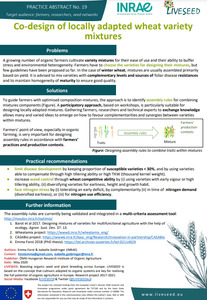{Tool} Co-design of locally adapted wheat variety mixtures (Liveseed Practice Abstract). Creator(s): Forst, Emma and Goldringer, Isabelle. Issuing Organisation(s): INRAE - National Research Institute for Agriculture, Food and Environment. Liveseed Practice abstracts, no. 19. (2020)
|
PDF
- English
(Co-design of locally adapted wheat variety mixtures)
1MB | |
![[thumbnail of 2022-07-26 21_14_10-PowerPoint Presentation.png]](/38785/3.hassmallThumbnailVersion/2022-07-26%2021_14_10-PowerPoint%20Presentation.png)  Preview |
Image (PNG)
- Cover Image
- English
145kB |
Document available online at: https://www.liveseed.eu/wp-content/uploads/2020/11/PA19_Co-design-of-locally-adapted-wheat-variety-mixtures.pdf
Summary in the original language of the document
Practical recommendations: Limit disease development by keeping proportion of susceptible varieties < 30%, and by using varieties able to compensate through high tillering ability or high TKW (thousand kernel weight). Increase weed control through wheat competitive ability by (i) using varieties with early vigour or high tillering ability, (ii) diversifying varieties for earliness, height and growth habit. Face nitrogen stress by (i) tolerating an early deficit, by complementarity (ii) in time of nitrogen demand (diversified earliness), or (iii) for nitrogen use efficiency.
| EPrint Type: | Practice tool |
|---|---|
| Teaser: | Look at farmers'point of view. |
| What problem does the tool address?: | A growing number of organic farmers cultivate variety mixtures for their ease of use and their ability to buffer stress and environmental heterogeneity. Farmers have to choose the varieties for designing their mixtures, but few guidelines have been proposed so far. In the case of winter wheat, mixtures are usually assembled primarily based on yield. It is advised to mix varieties with complementary levels and sources of foliar disease resistances and to maintain homogeneity of maturity to ensure good quality. |
| What solution does the tool offer?: | To guide farmers with optimised composition mixtures, the approach is to identify assembly rules for combining mixtures components (Figure). A participatory approach, based on workshops, is particularly suitable for designing locally adapted mixtures. Gathering farmers, researchers and technical experts to exchange knowledge allows many and varied ideas to emerge on how to favour complementarities and synergies between varieties within mixtures. Farmers’ point of view, especially in organic farming, is very important for designing assembly rules in accordance with farmers’ practices and production contexts. |
| Country: | France |
| Type of Practice Tool: | Practice abstracts |
| Agrovoc keywords: | Language Value URI English seed http://aims.fao.org/aos/agrovoc/c_6927 |
| Subjects: | Crop husbandry > Breeding, genetics and propagation |
| Research affiliation: | European Union > Horizon 2020 > Liveseed European Union > Horizon 2020 > Liveseed > Liveseed tools France > INRA - Institut National de la Recherche Agronomique European Union > Organic Farm Knowledge |
| Horizon Europe or H2020 Grant Agreement Number: | 727230 |
| Related Links: | https://organic-farmknowledge.org/tool/38785, https://www.inrae.fr/ |
| Project ID: | ofk |
| Deposited By: | Ortolani, Dr. Livia |
| ID Code: | 38785 |
| Deposited On: | 24 Mar 2021 08:17 |
| Last Modified: | 02 May 2024 10:32 |
| Document Language: | English |
| Status: | Published |
Repository Staff Only: item control page

 Download Statistics
Download Statistics Download Statistics
Download Statistics
